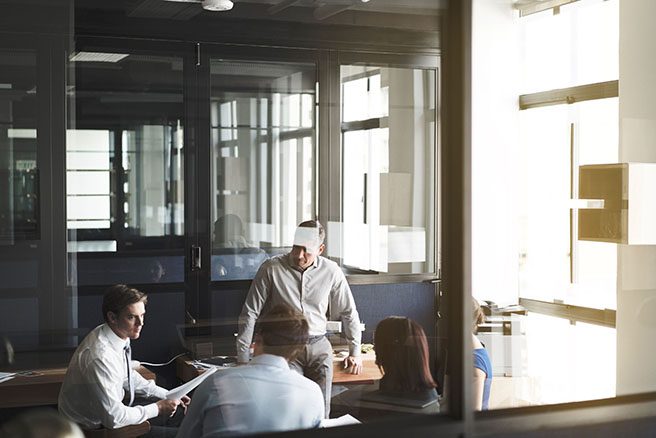This article was first published by Praxity Global Alliance on the 8 August 2020
As organisations seek to refine their Covid-19 response strategies, there are still many unknowns but one thing is clear: the most agile, digitised and responsive businesses stand more chance of success.
Companies with advanced online processes, and those able and willing to embrace digitalisation and remote and flexible working, have fared better to date. These businesses appear better placed to bounce back.
But not all the changes imposed during and post-lockdown have been welcome or indeed effective. And some elements, such as 100% virtual meetings and home-based working, are already being reversed in countries where Covid-19 cases are low.
This raises important questions about how best to respond to the fast-changing health and economic situation for business resilience and employee wellbeing.
Should senior company leaders continue on a path to digitalisation, virtual meetings and remote working? Which pre-Covid ways of working that can safely be brought back to improve productivity and customer and employee satisfaction? What’s viable long-term?
There are no easy answers. The impact of the pandemic varies hugely in different sectors and geographies, and with new studies into the spread of the virus emerging daily, it is difficult to make predictions, even in the short-term.
However, a report by McKinsey provides a useful reference point for companies learning how to deal with the impact of the virus, including shifting customer and employee expectations.
The report provides latest Covid data and trends to help senior leaders understand how the situation may unfold. It urges prompt action to protect employees, customers, supply chains, and financial results. This includes faster decision-making, building new capabilities quickly and at scale, and being more agile to respond to knowledge about the virus.
McKinsey specialists identify four key forces defining the next normal:
- Increased online sales and new patterns of consumer behaviour;
- An altered workforce – mass remote working, greater job vulnerability but also job shortages where newly needed skills are required;
- Regulatory uncertainty with increased likelihood of new regulations favouring local economies;
- Constantly changing safety interventions in response to greater knowledge about Covid-19.
These forces will inevitably be stronger in some countries than others, depending on the impact of the virus, the economy and the success of government action.
If we look at what’s currently happening around the world, there are clearly vast differences in the way organisations are transitioning.
In Austria, a highly developed and industrialised economy, and where the infection curve was flattened swiftly after strict and decisive measures by the government, digitalisation has advanced but the move to remote working may not be as popular or as permanent as some analysts predict.
Kurt Schweighart, Senior Partner at independent accounting firm LeitnerLeitner says: “Digitalisation is no longer a discussion point. The crisis has accelerated adoption, which can only be a good thing.”
However, the trend towards remote working is not as clear cut. Kurt explains: “Since the end of May, most of our Austrian teams have returned to offices. Although many team members enjoyed home working, and for two months it worked well, it was never anticipated to be a long-term work model. It can suit certain people, but not everyone. It is certainly useful for some service lines to meet in person. Equally, using technology for a quick video call to exchange views with clients is now well accepted and certainly a more productive use of time.”
In China, 99% of large enterprises outside Hubei, the region where the virus first spread, have resumed work while 50% of consumers are optimistic that the economy may recover soon after the end of the outbreak, according to McKinsey data. Here, as in many countries, digitally-optimised and health-related companies are growing quickly while those unable to embrace remote working during times of Covid-19 incidents may be more likely to struggle.
The situation in China is complicated by the risk that multinationals may pull out of the country, encouraged by government stimulus from elsewhere. Bloomberg reports that Japan has earmarked US$2.2bn to help manufacturers shift production from China. This trend towards localisation may become a global phenomenon.
It could be argued that a greater focus on digitisation and flexible working, and a rise in tit-for-tat government action would have happened irrespective of Covid-19. The difference during the Covid situation is the incredible speed of change and the fact we simply don’t know what will happen.
With so much uncertainty and so many variables, what’s the best way forward for your organisation to navigate this critical period?
The McKinsey report urges senior leaders to:
- Set up a “nerve centre” with clearly defined teams to manage planning and implementation;
- Evaluate the net benefit of remote work to your organisation and the readiness of your workforce to go remote;
- Monitor industry and regional recovery signals to assess timing of return;
- Build a return plan based on monitoring, best practices and outside-in risk assessments.
In terms of changing work patterns, organisations need to focus on inspirational leadership and creating a culture where remote working employees are respected and supported, according to McKinsey analysts. Clear guidelines and new working norms should be established, and organisations should actively engage with employees on organisational health while also fostering a sense of purpose for employees.
The timing and scale of change required will vary depending on geography. In the US and India, where Covid-19 cases were rising steeply at the time of writing, organisations will be under greater pressure to speed up digitalisation and remote working strategies in case stricter lockdowns are enforced.
As companies change the way they operate, effective communication will be more important than ever. David Rodarte, Director and Strategist for Growth and Succession Planning at US accounting firm BKD, stresses the need for a more holistic approach to engage all stakeholders.
In a recent article on crisis leadership, David says focusing on fundamentals and forward visibility are mandatory, supported by increased communication with customers, suppliers and employees to “attain the business intelligence you need to make sound decisions”. He adds: “Your employees, shareholders and suppliers also require a high level of attention. They seek calm, honest communication and affirmation that you value their relationship.”
Kurt adds: “Communication in a crisis is key. That’s not just about talking to people, but also maintaining focus and giving people clear leadership. Creating a sense of family, as we do, helps to create a bond in hard times. Conveying to clients that you really care about their needs and understand their issues is equally critical, not just now but always. Be proactive and solve problems. Don’t just put them on the table.”
Companies need to look beyond the uncertainties of the moment. While the McKinsey report provides a good reference point in terms of strategy, David puts forward four additional ways to effect positive change:
- Embrace unconventional ideas
- Pivot your business model to new opportunities
- Empower small work groups to act
- Maintain research and development (R&D) initiatives to leapfrog competition
This super-agile approach, where established organisations behave more like start-ups, quickly shifting business models to pursue new possibilities is already happening. In Australia, where the government acted quickly and decisively and where Covid cases have remained many companies changed focus early on.
Nick Hatzistergos, Chairman of independent accounting firm William Buck in Australia, says, “as much as Australian businesses were suffering, many also proved their resilience and how good they are at reinvention. Some pivoted business models from retail to delivery. DIY shops assembled home renovation packs for door drop delivery. Microbreweries and artisan distillers switched from beverages to making sanitizer. There was an abundance of entrepreneurship.”
Independent accounting firms within Praxity Global Alliance are playing a significant role in helping organisations effect change, especially in terms of monitoring risk, managing data, advising on cybersecurity, dealing with transfer pricing (TP) and developing plans for business resilience.
Nick adds: “As we emerge from the crisis there will be so many complexities for multinationals to manage in relation to transfer pricing, from intercompany lending to changes in a company’s permanent establishment footprint. Although the majority of the multinational client work we undertake at William Buck is inbound, being part of the Praxity Alliance means those clients we serve will inevitably face complex TP and SGE (Significant Global Entities) reporting challenges. Being able to lean on our colleagues with expertise in their domestic market will be imperative.”
Deciding what to change and what to retain going forward will be a massive undertaking in the coming months and years. Organisations need to be agile enough to enable quick changes to processes and work patterns, but also capable of reversing changes if appropriate, as the situation unfolds. Putting in place the people and structure to respond quickly and effectively, and tapping into support from global business experts, will be key.



































